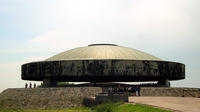Lublin and Majdanek 1 Day Tour from Warsaw
Warsaw, Poland
Trip Type: Day Trips
Duration: 1 day
Discover Lublin, the most important cultural and also the biggest academic center in Eastern Poland. Old buildings and ruins create and atmosphere that is unique to this city. You may also pay your respects to Majdanek Nazi Camp (KL Lublin), a Nazi concentration and extermination camp.
More About This Activity All Day Trips →
Discover Lublin, the most important cultural and also the biggest academic center in Eastern Poland. Old buildings and ruins create and atmosphere that is unique to this city. You may also pay your respects to Majdanek Nazi Camp (KL Lublin), a Nazi concentration and extermination camp.Discover Lublin, which was competing for the title of the European Capital of Culture 2016, because it presents an idea of integration, tolerance and dialogue between cultures of the West and East. The large amount of cultural festivals, galleries, theaters and places for artists is very impressive. You’ll never feel bored in this city.
On the outskirts of Lublin you will visit, Majdanek, a historic Nazi concentration and extermination camp. It is a unique example of a Nazi camp located near a very populated area. The camp was going to be the source of a free workforce for the realization of the plans to build a German empire in the east. Prisoners came from nearly 30 countries, mainly Poles and Jews, also Russians, Byelorussians, Ukrainians and other. The tragic history of the Lublin concentration camp came to an end on July 23rd, 1944 after the Red Army entered the city. Now you can visit Majdanek National Museum, Monument of Struggle and Martyrdom at Majdanek, Mausoleum containing ashes from the victims of Nazi hate and some remains of the camp.
On the outskirts of Lublin you will visit, Majdanek, a historic Nazi concentration and extermination camp. It is a unique example of a Nazi camp located near a very populated area. The camp was going to be the source of a free workforce for the realization of the plans to build a German empire in the east. Prisoners came from nearly 30 countries, mainly Poles and Jews, also Russians, Byelorussians, Ukrainians and other. The tragic history of the Lublin concentration camp came to an end on July 23rd, 1944 after the Red Army entered the city. Now you can visit Majdanek National Museum, Monument of Struggle and Martyrdom at Majdanek, Mausoleum containing ashes from the victims of Nazi hate and some remains of the camp.
« Go Back

